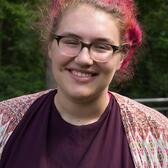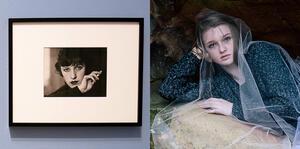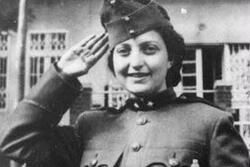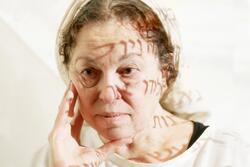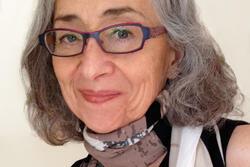Bravery In Negatives And Movement: Lotte Jacobi
Art as a form of healing. Art as a form of escape. Art as a form of human connection, or livelihood, or emotional fulfillment. Art as everything that you need it to be. A popular and fluid concept to be sure, but Jewish women tend to take things to a whole ‘nother, and totally badass, level of intensity. There are 20+ Jewesses I could name (whether observant or not) that have rocked a largely patriarchal art world. However, it’s important to remember that the squeaky wheel gets the grease. This elementary school proverb is usually applied to persistence: ask continuously and you will be rewarded with some piece of candy or a bathroom pass. The squeaky wheels that get the grease also tend to get the most positive feedback — pats on the back, retrospectives at the MoMA or the Metropolitan, maybe even widespread fame and recognition. It is when this proverb is applied to real life that we overlook the resilient, the quiet, and the stoic; we seem to forget about those that fly slightly under the mainstream radar. Because of this mentality, many have overlooked one of the most formative early portrait photographers of the late 19th/20th centuries: Lotte Jacobi. She sprang onto the scene in 1896 in West Prussia (AKA Germany, for those who missed out on Eurocentric history classes), out of the womb, into the photo studio, and into my heart.
I am young and Jewish and a photographer, and I also identify as a female, so Lotte and I have at least three different systems of oppression, with varying degrees of intensity, in common. In terms of photography, our practices differ greatly, but ultimately, our goal is the same. I enjoy what she enjoyed, capturing life, vitality, personality. Fleeting moment meets trigger finger meets image on film or in pixels—almost like magic.
Even though Lotte and the rest of the Jacobi family were entrenched in the leftist and revolutionary movements in Berlin, where they lived and owned a photography studio, the German officials that frequented for portraits would never have known. In fact, Lotte was so good at running the studio and making portraits that she was granted honorary Aryan status by the Nazis in 1935 because artistic ability trumped Nazi supremacy, apparently. She rejected the offer and fled, first to London and then to New York City. This is where Lotte established herself. She photographed elite European émigrés, prolific authors (JD Salinger and Robert Frost to name a couple), an old friend and casual cool scientist Albert Einstein, and Eleanor Roosevelt. Lotte was hangin’ with the big dogs while she simultaneously humanized them. Lotte treated her subjects as people, without the pedestal on which their accomplishments placed them. Her approach to photographing them was informal because she understood that, ultimately, they had personalities beyond their political position or scientific discovery or literary masterpiece.
Using movement and human life in photographs is something that I have embraced as being essential. Lotte was the same way, though the act of making a photograph like that was, for her, rebellious because it defied the stoic and starched conventions of what a portrait was supposed to be in the early 20th century, that is posed, stiff, formal, still. She was politically active, tenacious and Jewish, three adjectives that I would not hesitate to use to describe myself; she didn’t let a field that was dominated by stuck-up dudes with big cameras and bigger egos stop her from serving as a trailblazer for that truly American way of photographing that embraces wrinkles and dust and frizzy hair and in-between faces. That rebellion is the key difference between Lotte and me. I would like to believe that I am as brave as Lotte Jacobi, yet as much as I identify with Lotte, I could not say that for certain.
Lotte and I have a fundamental background difference. Even when I resided in the depths of Texan Protestantism, I never feared for my life because I was Jewish, and I certainly didn’t have to wait on Nazi officers knowing that they hated everything I stood for. The fear and knowledge of rampant anti-Semitism is presumably what drove Lotte to (almost) never speak about her Judaism post-immigration. This fear is something that I cannot relate to. There is a distinctive type of despair and oppression that came along with concentration camps and yellow stars and shattered windows of Jewish stores that I will never experience. These things are fundamentally traumatic. In Texas, I dealt with people asking me whether or not Jews worshipped Satan and with not getting invited to their lake houses, but never the threat of genocide. My Judaism has been allowed to grow and change radically since I lived in the South. I have never been afraid of what would happen to me because of this process. I talk about being Jewish in some capacity at least once every day; I have been allowed to publicly wrestle with concepts of Zionism, Torah, and prayer, and this is a privilege that I can hope to have for the rest of my life.
Lotte is braver than I am because she was confronted with Nazi Germany and anti-Semitism and she still did her thing. She asserted her place in the world. She created, collaborated, mentored, and thrived in a country that wasn’t her own. I hope that when I am frozen and afraid in the face of something seemingly larger than myself, I can be half as brave as Lotte was.
This piece was written as part of JWA’s Rising Voices Fellowship.

